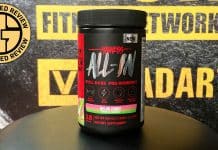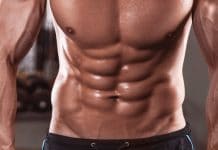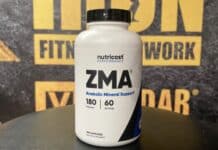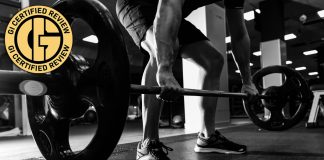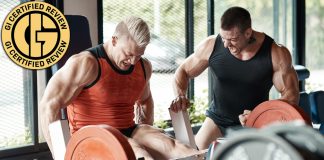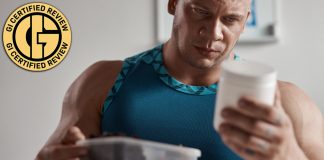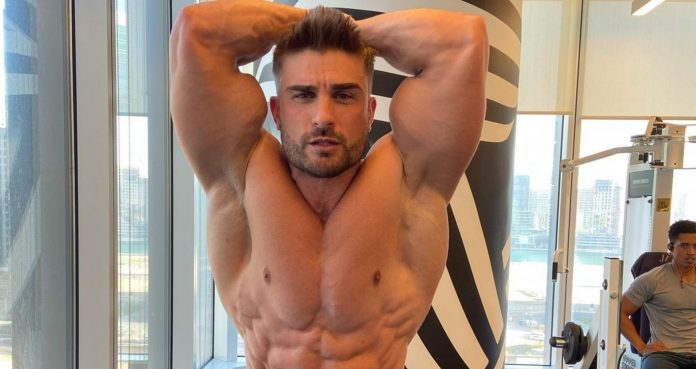
Ryan Terry begins his shoulder routine targeting the often-overlooked rear delts.
Robust and well-defined shoulders enhance your physique and improve the flexibility and mobility of the deltoid muscles, contributing to a V-shaped torso that accentuates a slender waist. The pursuit of sculpting 3D shoulders is recognized for its significant role in achieving an aesthetically pleasing body shape that is widely admired (1).
Ryan Terry, the first British athlete to clinch the Arnold Classic Men’s Physique title and the current Men’s Physique Olympia champion, recently shared insights on achieving the ideal 3D shoulders. Just a week before beginning his preparation for the 2024 Olympia, he uploaded a tutorial to his YouTube channel. This video guides viewers through building perfect 3D delts and includes valuable arm-strengthening exercises. Let’s delve into his expert advice below.
| Full Name: Ryan Terry (Men’s Physique Bodybuilder) | ||
| Weight | Height | Date Of Birth |
| 185-195 lbs | 5’10″ | 1988 |
| Division | Era | Nationality |
| Men’s Physique | 2010s, 2020s | British |
View this post on Instagram
Ryan Terry’s Shoulder Routine
The Men’s Physique Olympia champ likes to start the day with coffee before hitting the gym. Ryan Terry then does the following delt routine:
| Exercises | Sets | Reps |
| Standing Cable Rear Delt Fly | 2 warm-up sets, 3 working sets, quadruple drop set | N/A |
| Seated Barbell Press | 2 warm-up sets, 3 working sets | 8-10 |
| Barbell Front Raise | N/A | 8-10 |
| Barbell Lateral Raise | warm-up sets, 4 working sets | 10-12 (pyramid training) |
| Superset: Dumbbell Shrug & Plate Shrug | N/A | 10-12, 20-rep finisher |
| Machine Shoulder Press | N/A | N/A |
| Triceps Dip | N/A | N/A |
| Cable Triceps Kickback | N/A | N/A |
Standing Cable Rear Delt Fly
Ryan Terry starts his shoulder exercises with the cable rear delt fly. He likes to hit this exercise first because it’s easy to overlook the rear delts. The shoulder has three heads; this exercise isolates and targets the rear delts. He starts with two warm-up sets to get the blood flowing. Studies show that performing warmups before major exercise can improve your exercise performance (2).
“THE REASON WE’RE HITTING THIS FIRST IS IT’S VERY EASY TO NEGLECT THE REAR DELTS BECAUSE MOST PEOPLE WANT TO COME IN AND LIFT SOME HEAVY WEIGHT ON SHOULDERS. ALTHOUGH OBVIOUSLY, A PRESS hits ALL THREE HEADS, THIS IS JUST ISOLATING THE REAR DELT, WHICH IS ONLY A SMALL MUSCLE GROUP. SO WE WANT TO REALLY TARGET IT FIRST, THEN MOVE ON TO SOME BIG PRESSING AFTER.”
Terry does this exercise on a functional trainer with the cables set at the highest level to get good work in his rear delts. The force from the cable puts constant tension on the targeted muscles, which induces muscle hypertrophy.
Seated Barbell Press
Next, Terry performs the compound exercise barbell press seated to hit all three deltoid heads. He says he wants to start with some feeler sets to familiarize himself with the exercise and perform three working sets of eight to ten reps. Ryan Terry will also use an inclined bench to increase his range of motion, keeping his elbows below his chest.
The British bodybuilder emphasizes the need for controlled movement during this exercise. He employs concentric and eccentric movements to keep the muscles under constant tension, which can induce strength and muscle growth. Also, towards the point of failure, he switches to partial reps to finish his set. Partial reps are equally effective for inducing muscle growth (3).
Barbell Front Raise
Next, Ryan Terry grabs the barbell for some barbell front raises. He works the front delts using slow and controlled movements, which causes the targeted muscles to spend longer under tension, inducing muscle growth. Terry does this exercise with about eight to ten reps, working his anterior delts and mid-back.
Barbell Lateral Raise
Ryan Terry switches up his exercise a bit for the barbell lateral raise. He says he likes to use dumbbells for this routine but opts for a barbell this time. The champion executes this workout using pyramid training and emphasizes strict form.
“SO YOU DON’T COMMONLY SEE THIS. MOST PEOPLE OBVIOUSLY HEAD FOR A DUMBBELL, BUT IT’S JUST A DIFFERENT VARIATION. WE DID DUMBBELL WORK LAST WEEK. WE JUST TRYING SOMETHING DIFFERENT JUST TO SHOCK IT IN A DIFFERENT WAY.”
Ryan Terry uses unilateral movement, working on each side of the body equally and with strict form. Performing this exercise works the lateral delts, building muscle mass in the shoulders. You can also use his unilateral movement to train for muscle imbalances or train through injuries.
Superset: Dumbbell Shrug & Plate Shrug
Terry does a two-in-one exercise in this round. He first shrugs the dumbbell with heavy weights to target his traps while being spotted. Ryan Terry then transitions to the plate shrugs and does similar movements, working similar muscles.
“WE’RE DOING A SUPER SET, ALL TRAP WORK, SO DUMBBELL SHRUGS INTO PLATE LOADED SHRUGS. SO WE’RE AIMING RELATIVELY HEAVY WEIGHT FOR ABOUT 10 TO 12 REPS, THEN GOING ONTO A 20 REP FINISHER. AS YOU CAN SEE, IT’S NOT REALLY ABOUT THE FORM ON THE SECOND PART. IT’S NOT ABOUT THROWING IT UP, BUT IT’S JUST ABOUT KEEPING THE BLOOD IN YOUR TRAPS AND JUST MAKING SURE YOU GOT NOTHING LEFT.”
Machine Shoulder Press, Triceps Dip, & Cable Triceps Kickback
Finally, Ryan Terry rounds up his shoulder training with the machine shoulder press. He does a couple of reps and, at the point of failure, has his spotter assist him with his remaining two reps.
Next, since Terry considers triceps dips one of his most effective exercises, he does some reps of them. Usually, he likes to lean forward, which helps and targets the chest, but after his initial rigorous shoulder workout, he wants to get anything in his body moving. To end his routine, he does the cable triceps kickback to work his triceps muscles.
Generation Iron Exclusive Interview with Men’s Physique champ, Ryan Terry
Follow us on Instagram, Facebook, and Twitter for more bodybuilding workouts!
References
- Horvath T. (1981). Physical attractiveness: the influence of selected torso parameters. Archives of sexual behavior, 10(1), 21–24. https://doi.org/10.1007/BF01542671
- Fradkin, A. J., Zazryn, T. R., & Smoliga, J. M. (2010). Effects of warming-up on physical performance: a systematic review with meta-analysis. Journal of strength and conditioning research, 24(1), 140–148. https://doi.org/10.1519/JSC.0b013e3181c643a0
- Goto, M., Maeda, C., Hirayama, T., Terada, S., Nirengi, S., Kurosawa, Y., Nagano, A., & Hamaoka, T. (2019). Partial Range of Motion Exercise Is Effective for Facilitating Muscle Hypertrophy and Function Through Sustained Intramuscular Hypoxia in Young Trained Men. Journal of strength and conditioning research, 33(5), 1286–1294. https://doi.org/10.1519/JSC.0000000000002051




